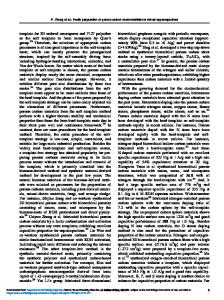Nanocomposite Particles for the Preparation of Advanced Nanomaterials
- PDF / 1,097,506 Bytes
- 12 Pages / 414.72 x 648 pts Page_size
- 53 Downloads / 370 Views
ABSTRACT New composites based on nano-size particles provide a promising route to the fabrication of novel materials for advanced technology applications. To produce desired materials, it is important to control the composition and distribution of nanoclusters within the bulk or surface coating of nanostructured materials. Towards this purpose, we have developed a novel method of processing nanocomposite materials utilizing colloidal chemistry techniques to tailor their microstructure. Unique composite aggregates of nanoparticles with a core-shell structure were prepared using a special scheme of controlled polymer adsorption. Polymers which specifically adsorb on both nano- and micron- size particles are used as tethers to enable desired coating of the later particles with the former and to enhance the cluster integrity. Nanocomposite particles consisting of micron-size alumina or silicon nitride as cores and nano-size alumina, titania, or iron oxide as shell particles have been successfully prepared using this process. The surface charge of the core particles is reversed after the adsorption of polyacrylic acid polymers. This promotes the interaction between the core and the shell particles and therefore nanoparticles added subsequently to the core particle suspension coat on core particles by electrostatic as well as possibly hydrogen bonding bridging mechanisms. Success of the process depends to a large extent on the absence of homoflocculation of nanoparticles and this is achieved by removing all the unadsorbed free polymers from the bulk solution before introducing them to coat on the polymer coated core particles. Coating itself is estimated by monitoring change in the zeta potential of core-shell structure. The coating scheme as well as the characterization of these nanocomposite particles are discussed in detail. This processing scheme provides a simple way for the preparation of both bulk and surface coatings with these engineered nanostructured particles as building blocks. INTRODUCTION Synthesis and processing of nanomaterials have drawn considerable attention in recent years [1,2]. The exceptional properties of these nanomaterials have made them potential materials for advanced applications in the 21 th century. The speciality of these nanomaterials lies largely on their ultrafine grain size and microstructures. Decreased grain/particle size in these materials suggests also the hugh expanse of interfaces and surfaces inside them. Higher energy state and dynamic nature of these interfaces separate these nanomaterials from those of traditional microstructures. Currently there is considerable effort devoted to the synthesis of nanoparticles and clusters. Processing of these ultrafines is however done mostly following current techniques that are problematic and remains challenging because of difficulties in dispersing and mixing of the nano-particles/clusters. Due to their small size, particles of nano- and sub-micrometer size tend to agglomerate. Wet processing methods utilizing colloidal techniques can b
Data Loading...










